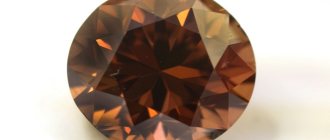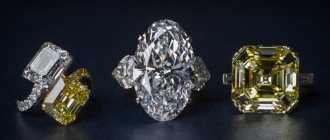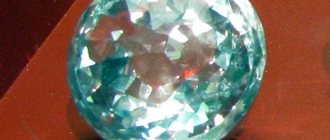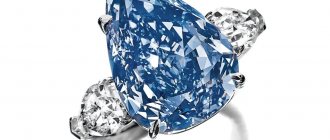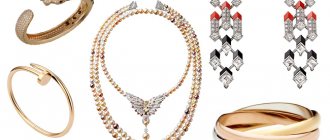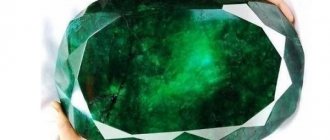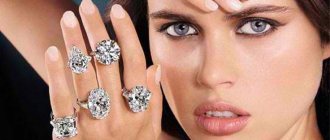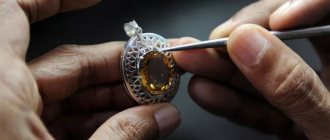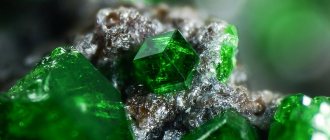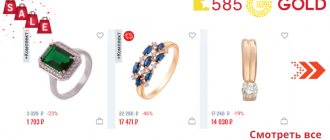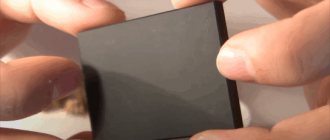Where is the best place to choose diamonds?
As a rule, it is recommended to purchase precious stones in jewelry stores. This way, you can assess the quality of the stone in a relaxed atmosphere, and, if necessary, look at the gemological certificate, which contains data on weight, clarity, type of cut and other parameters. In addition, if you suddenly have complaints about the quality of a gemstone, you can contact the salon and sort out the problem.
Some people choose stones from specialized online stores or at auctions. But, before making any online purchase, read reviews about a particular online site and thoroughly study the history of the company.
Where are diamonds sold?
A prestigious place for selling stones is auctions like Sotheby's. But only the best diamonds are sold here.
Ordinary consumers choose from the following options:
- specialized salon or online store;
- representative .
If you are accustomed to shopping in online stores, it is advisable to choose diamonds from two or three. View the range, read reviews.
The level of the usual salon (offline) is indicated by the conditions created for the buyer:
- There is a place where you can calmly, without prying eyes, evaluate a stone before purchasing. Including using special tools: 10x magnifying glass, carat scales, etc.
- The client is not required to know how to use these devices. At his request, a sales consultant or in-house jeweler will do this. Education and qualifications of personnel will be a plus.
- There are tables with a breakdown of the main characteristics of the stone.
Buying second hand is possible if you are confident in the person’s honesty. But a stone certificate is required.
How to choose a diamond according to characteristics
Diamonds are used to set rings, bracelets, pendants and other jewelry. You can also purchase a gemstone separately, for example, to set it in a piece of jewelry made to order.
If you don't know how to choose diamonds when purchasing, a diamond certificate can help you. It is issued for all diamonds of natural origin and weighing from 0.29 carats. A document confirming the authenticity of stones is issued, for example, by the Gemological Center of Moscow State University and the Russian Gemological Laboratory, as well as various international organizations such as GIA, HRD Antwerp. The certificate contains:
· information about the manufacturer;
· Name of product;
date of manufacture, dimensions of the stone;
· type and grade of frame material;
· type and quality of cut.
Before choosing diamonds, read the certificate. Also consider a number of other characteristics.
Who issues certificates
A certificate of conformity is drawn up for each pebble. The official name is the Gemological Examination Act. Issued by gemological organizations or processors.
Number one on the list is the Gemological Institute of America (GIA). The GIA certificate is recognized by everyone. For example, the Israeli Diamond Exchange only works with it.
In the Russian Federation this is the Gemological Center at Moscow State University.
The document contains information about the main qualities of the stone: place of extraction and processing, carat weight, color, clarity, type of cut, fluorescence. Defects are described (quantity and nature).
The certificate number is stamped on a pebble, usually on a girdle (belt), and can be read under a magnifying glass.
Carat
The weight of diamonds is measured in carats (ct). One carat is equal to 0.2 g. This is how much one carob seed, which grows in the Middle East and the Mediterranean, weighs. Diamonds are divided into three types based on carat content:
· small - 0.29 ct or less;
medium - from 0.3 ct;
· large - from 0.7 ct.
As a rule, jewelers encrust rings and rings with large diamonds, while smaller options are chosen for earrings, brooches and other jewelry.
It is worth understanding that the weight of a gemstone does not always correlate with its size, but the price of stones of different categories can vary greatly. Thus, stones weighing 0.99 carats visually look the same as one-carat diamonds, but are slightly cheaper than the latter.
Remember the tricks of manufacturers
Small stones with characteristics such as 5/5 will appear visually yellow, so they will be set in yellow gold to smooth out this effect. And if a large stone has characteristics of 5/5, then visually you will not notice any admixture of color and are unlikely to distinguish it from the same stone with characteristics of 3/3, unless you are an expert gemologist. This diamond will be framed in white gold. Knowing this, you can save some money.
In addition to the stone, you should pay attention to the weight of the entire piece of jewelry. Good manufacturers do not skimp on gold, so a high-quality ring weighs at least 2 g. The shank will be dense and not thin, which will allow the product to last much longer than lighter analogues that can bend or break in half. The weight of gold used will not greatly affect the price of the product, because the main part of the cost is the price of the diamond in dollars, the rest is the percentage of the retail outlet and the brand.
Based on this information, everyone can decide for themselves where they can save money, what to close their eyes to, and where to be more attentive. Buy the best wisely, diamonds are a great investment for years to come.
Cut
Its brightness and appearance depend on the quality of stone processing. The type of cut and the accuracy of the angles determine the brilliance and beauty of a diamond. The quality of the cut is assessed on a letter scale:
· A - higher;
· B - good;
· B - average;
· G - low.
If you decide to choose a diamond ring or earrings, an important characteristic will be the cut shape. The classic version is considered to be a round cut with 57 facets. Stones cut in the shape of a heart, drop, square, rectangle or oval look original.
What are the best cut diamonds?
This is the main one, but it is not the only indicator that affects the cost of the stone and its appearance.
The way the jeweler cuts it is also important: the number of edges, their symmetry, polishing. A well-executed cut reveals all the beauty and charm of the gem, because it determines how the light will be refracted inside it.
To understand which diamond cut is better, you need to understand the types of stone processing and the difference between them. There is a so-called commercial (B, C) and ideal cut (A). The difference is that when using a commercial diamond processing method, attention is paid not to ideal proportions, but to less loss of weight and size of the gem. Therefore, the entire diamond may have an irregular shape or only a separate part of it.
The ideal cut focuses on correct proportions, symmetry, and neglects loss of weight and size. But, in turn, this increases the cost of a product with a perfectly cut gem. If you look at it from above, you can see the squares, which, intersecting, form the platform (upper part) and arrows. Stones with cut B and C do not have such a clear picture when viewed from above and from the side.
It becomes obvious which diamond is the best: the one that has a high degree of clarity and an ideal cut. But the cost of such stones will be high and not affordable for everyone. It is believed that the lighter the diamond, the more ideally shaped it should be, and vice versa, on dark ones, errors in the proportions of the facets are not so noticeable.
The parameter that determines the size of a gem is its diameter. Its weight and cut proportions also affect the carat value. Nowadays, the weight of one metric carat is 200 mg. It is impossible to give a single answer to the question of which carats of diamonds are better, because the carat does not affect the quality of the gem, but only its cost: the higher the carat value, the more expensive its price will be.
Color
Colorless stones
Transparent stones are considered the most valuable. Colorless diamonds are divided into nine groups. The first group includes absolutely transparent stones, and the ninth group includes brownish or visible yellowish stones. Stones of groups 3–5 are considered popular. There is also a letter-based international classification, in which the color of stones is distributed from D to Z.
It is impossible to visually notice the difference between the stones of the third and fourth, as well as the fourth and fifth groups. At the same time, the difference in price is quite noticeable. Therefore, when the question is which diamond to choose, the decision depends on whether you are willing to overpay.
Colored stones
The cost of colored diamonds is affected by the brightness and saturation of the hue. Most often, colored options are cheaper than colorless ones, but there are exceptions. Thus, stones of the so-called fancy colors can be more expensive than the most transparent samples.
Diamond classification
At the everyday level, it is believed that the main advantage of a diamond is its weight. Professionals evaluate comprehensively, according to the international 4C system. Cut, clarity, weight, color are taken into account (from the English cut, clarity, carat, color).
Cut
It is the cut that turns a dull diamond into an expensive sparkling diamond. Its type is chosen based on the shape, size, and quality of the pebble. Good work neutralizes flaws, emphasizes advantages, and preserves the original weight of the stone as much as possible.
More often, the crystal is cut classically - round diamonds with 57 facets (KR57) are beautiful. This is how many facets there should be on a stone over 0.3 carats. Very large expensive specimens are cut with values of 74, 86, 102; for small ones, an option with 17 facets is acceptable.
Fancy shapes such as heart, pear and marquise are popular.
Purity
The degree of purity determines how the stone reflects sunlight. According to the GIA classification, there are 11 purity groups - from IF (without flaws) to I3 (imperfect).
The Russian scale is different. A 9-point scale determines the purity of stones up to 0.29 carats inclusive; a 12-point scale evaluates crystals heavier than 0.3 carats. At the same time, 1 is the highest purity, 12 is the lowest-grade stones with significant inclusions.
Pebbles up to the seventh level are considered a good choice, so if finances are limited, choose a specimen from the “golden” mean based on purity.
Color
Almost all crystals are transparent or yellowish. According to international gradation, they are assigned a sign - from D to Z, indicating the degree of transparency and yellowness.
D is for “pure water diamonds.” Starting from H, the stones have a yellowish tint, which is visually distinguishable. Popular colors among Europeans are 4 and 5 (J and H).
In Russia, color is classified into 9 groups, from 1st – absolutely colorless diamonds to 9th – specimens with a pronounced yellow or brown tint. The price difference between them is two to three times. The best-selling stones are level 3–5, but it is impossible to determine by eye whether it is level 3–4 or level 4–5. It’s worth thinking about whether it makes sense to overpay.
For “white” crystals, the degree of colorlessness is valued. People of color are classified according to their color groups and subgroups. The characteristic includes the term fancy (that is, fantasy), a description of color and its saturation. Colored stones are usually cheaper. But bright, fancy blues, yellows, and greens are rare. They are considered the best, valued many times over, and sometimes an order of magnitude higher than classic colorless diamonds.
Weight
The Russian system is similar to the world one. Diamonds are weighed in carats to the second decimal place - one carat is equal to 0.2 grams.
Crystals according to this parameter are divided into categories (in carats):
- up to 0.29 – small;
- up to 0.99 – average;
- from 1.00 – large.
The weight of a stone in jewelry is calculated using special formulas. Knowledgeable people advise taking 0.99-carat copies. Visually, they are indistinguishable from one-carat ones, but are significantly cheaper.
Popular jewelry diamonds range from 0.30 to 1.00 carats. One-carat stones are used for rings, and smaller ones are used to decorate earrings.
Fluorescence
A high fluorescence rate reduces the cost of the stone by a third. Such specimens are identified by their luminosity in ultraviolet light.
Purity
Before choosing jewelry or stones separately, consider not only the carat value, but also the clarity of the diamonds. The radiance of stones is determined by their ability to transmit light rays: the lower the purity index, the less pronounced their shine.
Absolutely pure stones without any inclusions are quite rare, which affects their cost. Such samples are often sold without frames, and they are subject to mandatory certification. To assess the clarity of diamonds, there is an international scale consisting of 11 levels: from IF - an absolutely pure stone, to I3 - a diamond with defects and inclusions.
The Russian classification provides:
· for small stones - 9 purity groups;
· for large ones - 12 purity groups.
Perfectly clear diamonds receive a 1, while those with noticeable and/or numerous inclusions receive a 12.
If your goal is to choose diamond jewelry for beauty and not for investment, take a closer look at diamonds that belong to groups 3–4 in color and 1–7 in clarity. As a rule, it is better not to purchase stones of levels 9–12 - due to numerous defects, they often split and do not look very attractive.
Check out the features
What is usually written in certificates? There are two scales used to evaluate diamonds: color and quality (clarity). These characteristics tend to be unity, the color is ideally pure and transparent, and the quality is characterized by inclusions inside the stone, represented by graphite dots and cracks. In Russia, these characteristics are reflected in numbers, in the international scale - in letters. Their ratio is given in the tables below.
For example, you may see the inscription 5/6 on the product tag. This means that the color of the stone has a value of 5, and the quality (purity) is 6. The real characteristics of diamonds are considered to be 3/3 as close to ideal as possible. It is rare that a stone will receive a higher grade from a gemological center, but this also happens. This information is worth double-checking, because it makes the stone significantly more expensive.
Good characteristics of a large stone are considered to be from 3/5 to 4/5.
How to choose diamond jewelry: criteria for determining quality
Each piece of jewelry is attached with a tag indicating its characteristics. The same applies to large expensive diamonds that are sold without a setting. Let's look at an example of how to read a tag. Let's say we see the following: 5 KR-57 0.7 2/2 B.
What does it mean:
· 5 - the total number of diamonds in the jewelry;
· KR - cut shape, in our case, round;
· 57 — number of faces;
· 0.7 - the weight of one stone or the total weight of all stones in the decoration;
· 2/2 – color and clarity of diamonds on a scale from 1 to 9;
· B—cut level.
What to remember when buying a diamond
A professional gemologist or jeweler will help you choose the right jewelry. But since it is not always possible to take a knowledgeable person with you, it is advisable to remember several points:
· Decide on your purchasing budget. Consider how much you are willing to spend on a piece of jewelry or gemstone.
· Select several options, compare them with each other based on their main characteristics.
· Choose the product that best suits your price and quality.
· When purchasing a diamond, pay attention to the certificate - it must contain a detailed description of the stone’s parameters.
Experts recommend choosing jewelry with stones that have average gemological indicators - in the range from 3 to 5 (on a scale of purity, color). Such diamonds look decent in jewelry, and their cost is not prohibitively high.
What to consider when choosing a stone
The sparkling splendor of the showcase will easily make you lose your head. To prevent this from happening, you should only consider diamond products at affordable prices:
- Compare three to five copies of comparable quality and type.
- Choose a product with the best price-quality ratio.
- Analyze the certificate of authenticity. If it is not there, there is nothing to talk about. A document issued by a store is not a guarantee.
- Crystals with indicators of 1/1 (or similar) in purity and color should be chosen only as an independent object.
- Cheaper pieces are used for diamond jewelry: the setting will hide minor defects and visually change the shade.
A ring with a carat diamond is much more expensive than a similar one with several crystals of the same total mass.
How to distinguish natural stone from synthetic
Artificially grown diamonds are similar in physical and optical characteristics to natural ones. They are almost completely identical, except that synthetic stones are created in laboratory conditions.
Experts will help you accurately determine the origin of a gemstone. It is also quite possible to independently verify the authenticity of a diamond: for this you will need an ultraviolet lamp. Under the influence of ultraviolet light, natural stones glow with a light blue hue. Synthetic counterparts will typically have a yellow or green cast.
WHO ISSUES CERTIFICATES
- When buying a diamond, it is better to ask the seller to show the stone’s certificate.
- This is necessary because the diamonds may be synthesized or the seller may be dishonest.
- If the seller shows you a certificate, you should check that the certificate was issued for this particular diamond.
- The diamond is weighed and it is checked whether the given weight corresponds to that recorded in the certificate.
- You can also take a magnifying glass, carefully examine the stone and compare it with the certificate.
Certificates are issued by GIA. Such a document most realistically evaluates colorless stones. There are also PGGL, AGSL and LGP certificates.
How to choose the right diamond ring
When purchasing a diamond ring, consider the size of the piece as well as the shape of your hands and fingers. So, for those with large palms and long fingers, rings and washer rings with large stones are suitable. On petite hands with thin fingers, round and flat rings with several small diamonds will look good.
Focus on your own taste and financial capabilities. If you are purchasing jewelry as a gift, ask about the wishes of the person you plan to give it to.
To choose the right diamond ring, consider a number of characteristics:
· Type of cut. A classic round cut would be a universal option, but jewelry with inserts of other shapes looks no less impressive: “Marquis”, “Heart”, “Princess”, “Drop”, etc.
· Frame material. Platinum, white or yellow gold are usually chosen as the setting for a diamond.
· Weight of decoration. It is good when the product into which the stone is inserted does not look too fragile. Thus, diamonds look quite harmonious in jewelry weighing at least two grams.
· Condition of inserts. Inspect the stones in the ring with a magnifying glass - there should be no scratches, chips or other visible defects on the inserts.
An equally important parameter when choosing is the type of stone fastening. The way the diamond is set determines the design and appearance of the ring. In addition, it depends on how securely the gemstone is fixed in the jewelry.
There are several options for setting diamonds:
· deaf, partially deaf;
· speckled, fadenovaya;
· corner, pavé;
· carmesine, teak;
· invisible.
Buy rings only from jewelry stores that have a reliable reputation in the market. When choosing products with large diamonds, study the certificate of authenticity of the stones.
Weight (mass) of diamond
Now about the weight of the stone. As the size of a diamond increases, its price increases, but not linearly, but spasmodically. A jump in value occurs when the weight crosses 0.5; 1 carat and so on. Therefore, an experienced buyer will choose a stone weighing 0.49 carats rather than 0.51 carats; the difference in weight is imperceptible, and the cost savings are quite significant.
A ring with one diamond of 1 carat is more valuable than a ring with a scattering of stones weighing 0.01–0.09 carats. The total weight of the placer will be the same - 1 carat, but the cost of each individual stone is negligible. Don't be fooled by the value of "many" diamonds.
A little history of cutting
People have been processing stones, in particular diamonds, for several centuries. Before they learned how to polish diamonds, making them shine in the sun, they had almost no value among jewelers. Uncut stones looked too ordinary to inspire creativity. The first attempt to refine the mineral was made in the 14th century. Then they tried to polish its natural edges. By the end of the century, diamonds gradually began to turn into polished diamonds, attracting more and more attention to them.
In the 15th century, diamond cutting reached a new level, despite the fact that almost half the mass of the nugget was lost in the process. The popularity of diamond grew, but it was still inferior to gems - ruby and sapphire.
At the end of the 15th century, the master polisher of Bruges got down to business. He came up with the idea of arranging the faces of the mineral in absolute symmetry. I used my own invention for this. To achieve the perfect result, Brugge shaped the azmaz into pear, triangle and briolette shapes.
After another half a century, a new fashionable cut appeared - rosette or rose. The first stones processed in this way adorned the jewelry of Belgian craftsmen. The rose finish has been and remains more than popular. Many of the largest diamonds in the world were treated with roses. Example - Sancy and Orlov (India).
Diamond cuts in the form we know today only appeared in the mid-17th century. The finished nuggets were distinguished by 17 precise edges on the upper part of the surface. This finishing method was called double cutting. Over time, they came to the conclusion that the stone plays with light more and brighter if you add facets. A jeweler from Italy, Vincent Perutzi, proposed almost doubling their number. Even this was enough for the diamond to shine many times more than before. The name of the finish is Mazarin. Compared to Rose, she is more edgy and modern, but still not as vibrant as the later ones.
Two cutting options - Rose and Mazarin - were successfully used throughout the 19th century. And only at the beginning of the 20th century the first jewelry machines and professional diamond equipment appeared. Round cut diamonds have become fashionable.
The famous mathematical genius Tolkovsky came up with a special model for diamond processing that takes into account the properties of the nugget. However, the then perfect model today seems outdated. Stones cut according to Tolkowsky's principle reflected light only 2 times, whereas today this number has increased several times. Although at that time the theory of mathematics gave impetus to the development of the art of diamond processing.
In 1970, another scientist proposed a variant of diamond cutting. Its fundamentals are still used today as the basis for the formation of a computer model in rock finishing.
What you need to know about diamonds?
Precious stones are measured in such indicators as:
- carat;
- purity;
- color;
- cut.
These are the main parameters that you should consider when buying diamonds if you are not a professional. There are cases when only the carat value is indicated, and other numbers are missing. In this case, it is necessary to clarify detailed information. In addition, if such a characteristic as the color of a diamond can be considered, then in most cases purity can only be determined by an expert, while it is one of the most important values of the stone.
Buying diamonds, not fairy tales about them. Confessions of a Diamond Dealer.
This article is dedicated to the end buyers of diamond jewelry, although jewelry manufacturers may also find something useful here. I will also immediately note that all of the recommendations listed below mainly relate to the purchase of diamonds outside of Russia.
It so happens that most people mistakenly believe that diamonds are something rare and very expensive. In fact, diamonds, from which diamonds are actually cut, are mined in huge quantities, but only a small part of them has a high value. Approximately 3/4 of diamonds are generally used for technical needs due to the lack of any jewelry value. The remaining quarter of the best samples are cut, but this does not mean that all these stones are of high value. In fact, only a tiny fraction of them are highly valued. Absolutely, or at least relatively colorless and pure stones are truly valuable. Such stones are a tiny percentage of the total mass. After all, the bulk of diamonds, even jewelry-quality ones, have certain shades, most often yellowish or brown, as well as significant inclusions inside the stone. All this significantly reduces the value. For example, the cost of a colorless diamond weighing 1 carat can vary approximately 40 times and have a price range from $500 to $20,000.
In addition to colorless diamonds, there is also a group of colored ones. And the price range among colored diamonds is even wider, and the idea that all colored diamonds are highly valued is wrong. Only diamonds of rare colors (red, pink, blue, green) are highly valued. Diamonds of brown, yellow or mixed colors do not have a high value and are generally worth significantly lower than the same colorless diamonds. The value is influenced by the intensity of the color, and only the brightest examples of the same yellow diamonds can compete in value with colorless ones. Specimens with a slight yellow color, as well as any brown diamonds and stones with yellow-brown hues, which are often given the commercial names “cognac” and “champagne,” do not have high value. Sellers often take advantage of the fact that Rapaport does not keep statistics on prices for colored diamonds and the end consumer simply does not even know the approximate prices for these stones.
In general, many players in the diamond business build their business solely on ignorance of consumers. And this does not mean that you are always deceived; basically, they simply do not tell you or tell you only part of the information that is beneficial to the seller. Therefore, the final result in the form of price and quality of purchased stones will depend solely on you and your knowledge. They will talk to you and offer you options based solely on the level of knowledge you demonstrate. And it doesn’t matter where you look for stones or jewelry, in a store or at a diamond exchange. For some reason, many people think that if they decide to buy something on the stock exchange, they will definitely win something.
Firstly, the very fact of buying something on the stock exchange is already erroneous. The fact is that trading in stones on exchanges is carried out exclusively by members of the exchange and entry is closed to others. When you are brought into the exchange building to sell jewelry or stones, you are taken to one of the offices, but in this case, such offices, even while located in the exchange building, act as a retailer. Prices in this case will have nothing to do with internal exchange prices and will depend, again, solely on the level of your knowledge; prices will be announced solely on the basis of their impression of you. I won’t even talk about the shops located around the exchange! Their location is a banal marketing ploy to associate oneself at least somehow with the exchange. Both these shops and offices inside the exchange are regularly visited by groups of tourists from all over the world. And if you ever happen to find yourself in such a group, never, under any circumstances, buy anything in the place where the guide took you! It works like this: guides always bring tourists to the most expensive places, because only a store or office with crazy markups can afford to cooperate with guides who ask for up to 30%, and not profit, but gross prices! A guide is always “an extra mouth on the buyer’s neck.”
In order to buy worthwhile diamonds for the right price, you first need to understand the basics.
First, take into account the Rapaport sheet, this is statistics on average market prices for diamonds. The price for you, as the end consumer, should not significantly exceed the price in the sheet if the stone is close to ideal, and should be lower than the sheet if the stone has poor cut quality, irregular geometry and fluorescence. Also consider the fact that fancy diamonds (any shape other than a circle) are generally valued at a quarter less than round diamonds.
And second, consider only diamonds whose characteristics have been confirmed by the GIA laboratory. Without a certificate, you are highly likely to be deceived to one degree or another. Therefore, stand firm and do not give in to the persuasion of the seller, who will diligently persuade you to buy something with certificates from other laboratories or without them at all. You will hear the following arguments from sellers: the stone is too small for GIA inspection; verification takes a long time; checking is expensive and will greatly increase the price of the stone and much more. All these myths, which have already taken root in the brains of many people, are spread either by incompetent market participants who do not have the slightest idea about diamonds or the work of laboratories, or dishonest market participants who do this on purpose.
Therefore, if you hear from any jeweler or jewelry seller at least one of the myths I mentioned below, run away from there, because this is either an incompetent person or a scammer with whom you should not deal when buying jewelry. The first one will not sell you anything good due to his incompetence, and the second one will deliberately mislead and deceive you!
AND NOW ABOUT THE MYTHS:
Myth one. GIA does not accept diamonds weighing less than 1 carat or 0.5 carats for inspection, according to various sources. This is complete nonsense! GIA accepts stones of absolutely any size for inspection! This is confirmed by a photo of the result of testing a diamond weighing only 0.03 carats by the GIA laboratory! (see photo 1).
Photo 1. The result of testing a diamond weighing 0.03 carats by the GIA laboratory
Myth two. Inspecting diamonds at GIA is expensive, so it is not cost-effective to have small stones inspected. It's a bullshit! The GIA laboratory has a clearly stated price list for their services, which you can view on their official website. Diamond inspection costs between $50 and $100 per carat, depending on the certificate format. That is, the price of inspection directly depends on the size of the stone: the smaller the stone, the cheaper the inspection will be. Therefore, it is quite advisable to submit diamonds for certification even weighing 0.3 carats; there are a huge number of stones of this size that already have GIA certificates on the market, and this is justified; you can see an example of such a certificate in photo 2. Even good stones weighing 0.2 carats should be submitted for verification quite justified! After all, if the stone is good and costs, say, $300, why not get a certificate for it confirming its good characteristics by paying only $30. If a stone does not have a certificate, believe me, this is not due to the laziness of the seller or his saving of this $30; stones that have serious problems that the seller wants to hide from you are not submitted for certification; why does he need a certificate where all the negative aspects of the stone will be indicated! Therefore, if there is no certificate from a reputable laboratory for stones, especially those weighing about half a carat or more, you should be wary!
Photo 2. Certification of a diamond weighing 0.3 carats.
Myth three. GIA verification takes a very long time. Firstly, on the diamond market, suppliers sell a huge number of stones already with GIA certificates, and it is not difficult for a jewelry manufacturer to buy such stones if you don’t want to wait for verification. Secondly, the inspection itself usually takes about three business days, which, in my opinion, is not very long for one of the most competent and professional diamond inspections in the world. Therefore, if you are considering buying diamonds in the area of one of the diamond exchanges, where, in fact, the laboratories for testing stones are located, such excuses from sellers are groundless.
Myth four. GIA deliberately understates the characteristics of diamonds in order to appear cooler than everyone else. Such statements are, in my opinion, the height of cynicism, because all tables and testing standards, which are used by many laboratories around the world, except for Russia, where Moscow State University still works according to its own standards, are the brainchild of the GIA Institute, which began studying stones back in 1931 and is the founder of the entire stone inspection industry! So, GIA cannot underestimate anything by definition; all tables and criteria are their own standards. Therefore, it is not GIA that underestimates, it is other laboratories that overestimate, playing into the hands of the seller. After all, if a laboratory takes GIA tables as the basis for its work, it is logical to assume that it must also comply with GIA standards.
So if you hear the above-mentioned myths from sellers of diamonds, or jewelry with them, run away from them, they are trying to fool you!
But even if you have a GIA certificate, you should not let your guard down, otherwise they may sell you a bad, worthless stone, but at the same time tested by a serious laboratory. The fact is that the presence of a certificate does not mean that the stone is good or valuable, because laboratories simply describe all the characteristics of the stone as is, so it is important to be able to read the certificate and take into account all the factors.
Photo 3. An example of a certificate displaying information about the strengths and weaknesses of the stone.
Cunning sellers often resort to tricks, namely, sending problematic stones with low value to famous laboratories for testing, in order to thus give significance to their stones, taking advantage of the fame and name of the laboratories issuing certificates. And then they sell these stones at inadequate prices in the hope that the average buyer does not know how to read certificates, but will blindly believe that the stone has a serious certificate. As a rule, even a cheap stone does not have all weak sides and may have several strong points; the seller will use this when communicating with the buyer, focusing only on the strengths of the stone, demonstrating this in the certificate, and will remain silent about the weak points. An example of this is the certificate in photo 3. This stone has a fairly high clarity (VS-1) and cut quality (Exellent), and the seller will focus on these strengths. But it will ignore the very low color (M); in addition, the stone has a brown tint (brown), which greatly reduces the value of the stone! The stone also has a strong degree of fluorescence, which also negatively affects the value of the stone!
Photo 4. An example of a certificate displaying information about the strengths and weaknesses of the stone.
The second example is the certificate in photo 4. This stone has a high color (F) and fairly good clarity (si-1). But at the same time, the quality of the cut and polish (Good) is poor! This rating, despite the fact that it is translated as “good,” indicates serious deviations and will have a detrimental effect on the appearance of the stone and, as a result, significantly reduces the value of the stone. You should not consider the cut quality below Very good! Also, this stone has incorrect geometry (the stone is too elongated, the depth of the stone is 66% of its diameter, but should be 60%), this will have a detrimental effect on the return of light entering the stone, therefore, the stone will play poorly, and also such a stone will lose and externally, because due to the fact that it is elongated, the stone is smaller in diameter and, having a weight of 0.5 carats, will look like a normal stone weighing 0.45 carats (the stone has a diameter of 4.92-4.94 mm, while a regular half-carat should be about 5.15 mm)!
Photo 5. An example of a good diamond certificate.
In photo 5 you can see a certificate of a good diamond, worth both money and attention! The stone has the correct geometry (both depth and surface are close to 60%), high cut quality (3 Excellent), no fluorescence (None), high color (E), good clarity (VS-2). There was also no intervention in the stone (artificial improvements in color and clarity), by one method or another. For example, the cleanliness of a stone can be improved by removing inclusions with a laser and filling the voids with silicone or glass melt. Color can be improved by decolorizing the stone with HPHT technology or, conversely, by enhancing the color when it comes to colored diamonds. The color can also be enhanced by radiation by irradiating the stone. The fact of such interventions is always recorded in certificates; you can see an example in photo 6. Keep in mind that treated stones cost incomparably less than untreated ones.
Photo 6. An example of a certificate for artificially refined stone.
So buy diamonds with certificates from reputable laboratories and do not forget to carefully study each point, and also use the Rapaport sheet and you are highly likely to become the owner of worthwhile diamonds!
Authors: Vitaly Sayko and Igor Stiller
Vitaly Saiko Entrepreneur, blogger. International company Shtiller&V.S Ltd (Israel)
Diamonds with poor symmetry
| A round, oval-shaped diamond with a “butterfly” visual effect. This effect can often be found in fancy-cut diamonds in the shape of an oval and a drop (pear). | A 1 carat diamond with a diameter of 6.7 mm is stretched in diameter and has asymmetrical facets. An ideal cut diamond with this diameter should weigh 1.12 carats. |
| Height/Diameter,% | Area/Diameter,% | Diamond Cut Grading |
Move the sliders to visually see the impact of proportions on how a diamond interacts with light.
HOW TO DECODE A TAG
The tags indicate the weight of adamant, its shade, transparency, shape and type of cut, the presence of inclusions, and shine.
So, if the tag says “5Br-P49–5.5ct–2/3B”, this means:
- “5Br” - there are 5 adamants in the jewelry;
- “P49” is a cut. Each of the 5 diamonds has 49 facets and is cut into a Princess (P) cut.
- “5.5ct” is the sum of the mass of 5 stones;
- “2/3”, 2 – color, 3 – purity (according to the International VVS2 scale);
- “B” is the type of cut, that is, deep cut.
When purchasing a ring, you need to examine it from the inside. If the stamp says PT (Plat), which means “platinum,” you can be sure that this is a real diamond, since zirconium is never combined with platinum.
The letters CZ mean it is zirconium.
Diamond Clarity
Diamond clarity is another important parameter that is worth paying attention to. This concept defines its transparency and the absence of external defects of the diamond. According to this criterion, diamonds are divided into 12 groups and not only the attractiveness of the diamond, but also its external qualities and durability depend on it. In this regard, cleanliness is also of particular importance and is an integral parameter that is worth paying attention to.
When choosing the purity of diamonds, you should also focus on lower values; the closer the clarity value is to one, the higher its value. However, often the most valuable stones are not affordable for everyone, so there is such a thing as the most advantageous purity group. This is group 7, in which defects are visible only at 10x magnification using a magnifying glass, and are impossible to see with the naked eye. Therefore, if you plan to wear a diamond ring or pendant as jewelry, no one will ever guess that it has any defects. And the price of a diamond in which group will be the most profitable. It is better not to buy diamonds of clarity groups 8-12, as they may have defects that are visible without a magnifying glass. Stones below group 3 are very rarely used for the production of jewelry and are extremely expensive, bought for private collections and are of particular value. On the open market you can most often find diamonds and jewelry from groups 3 to 12.
